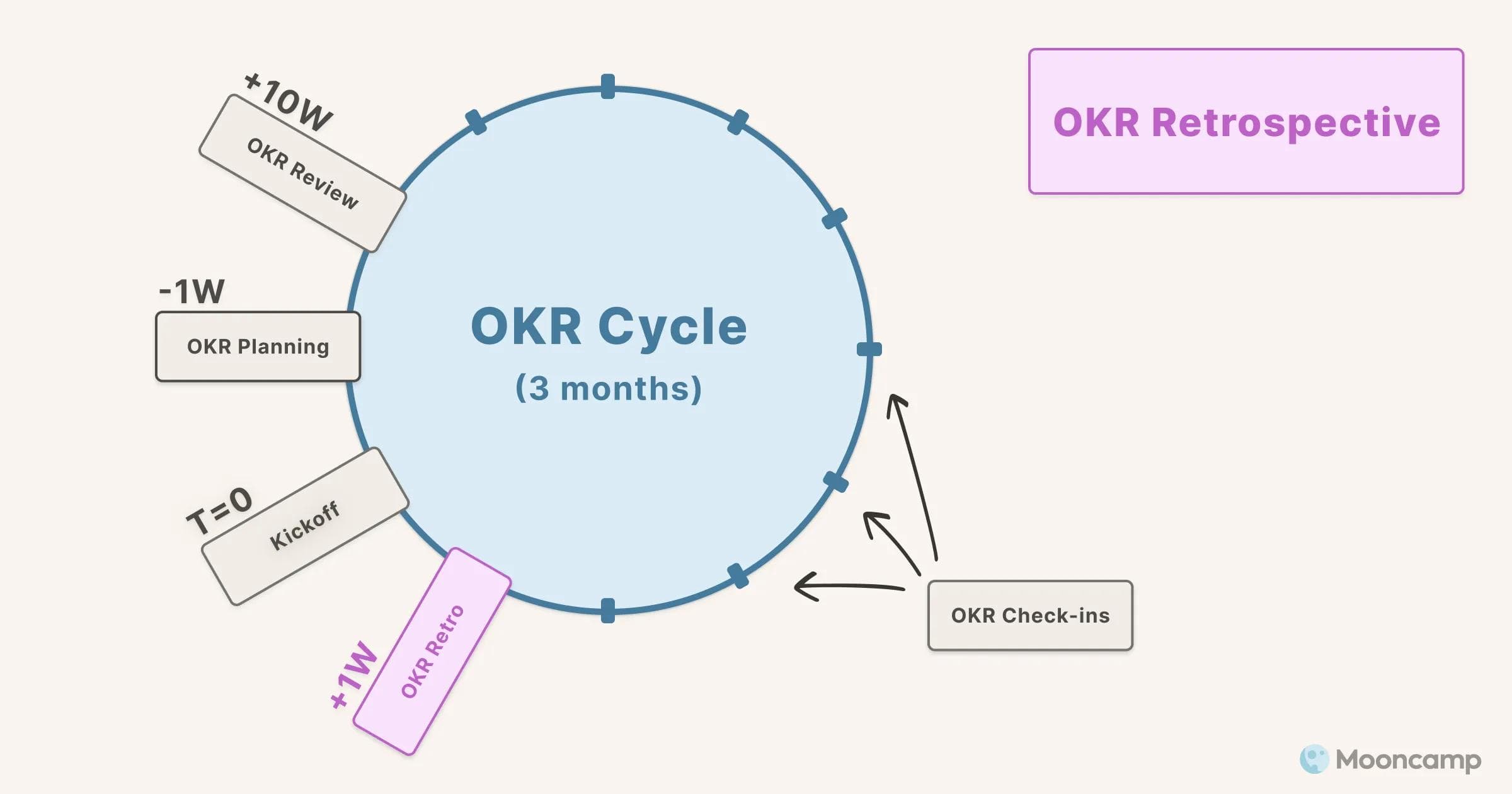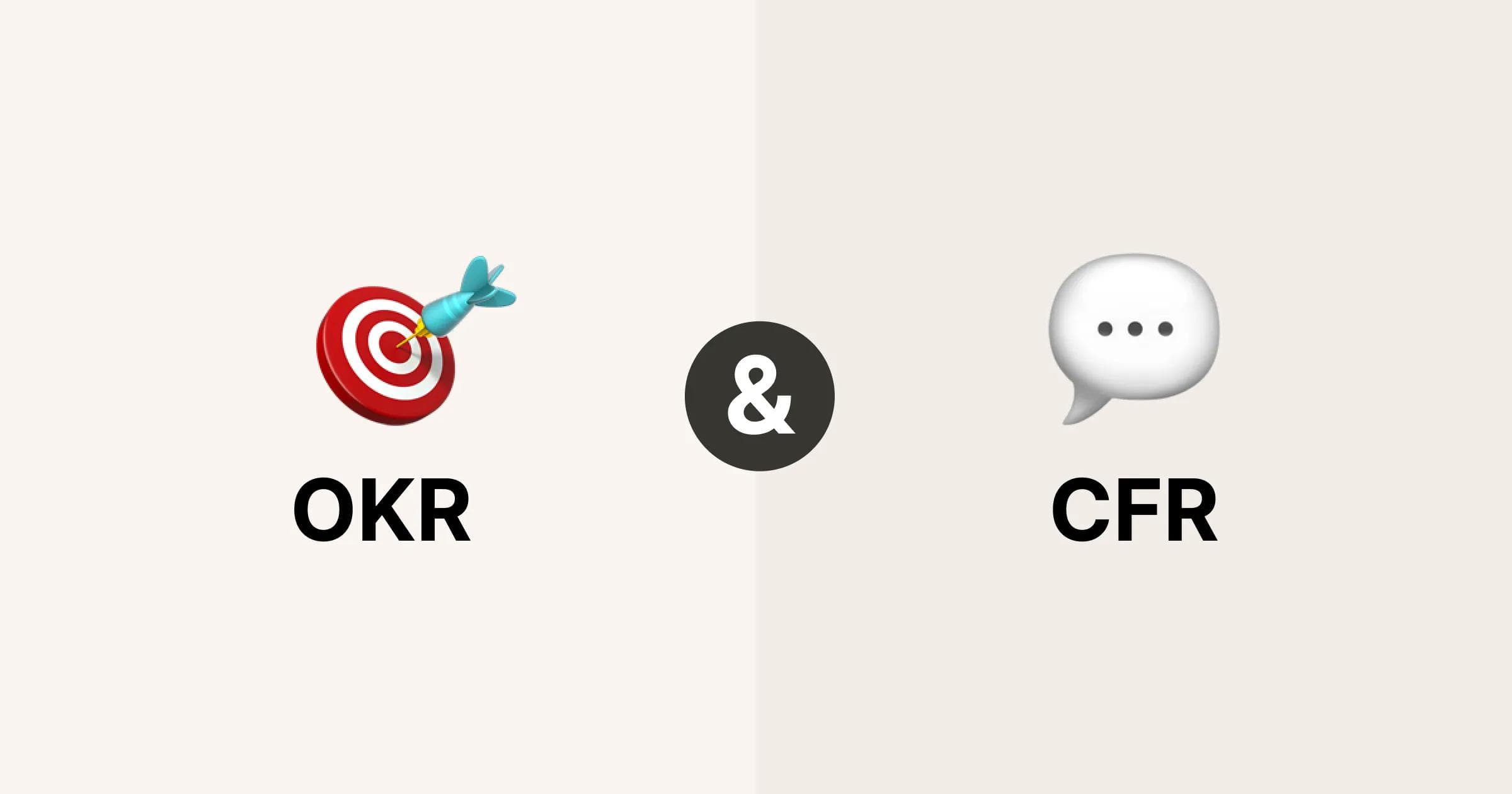QBRs and OKRs: The complete guide
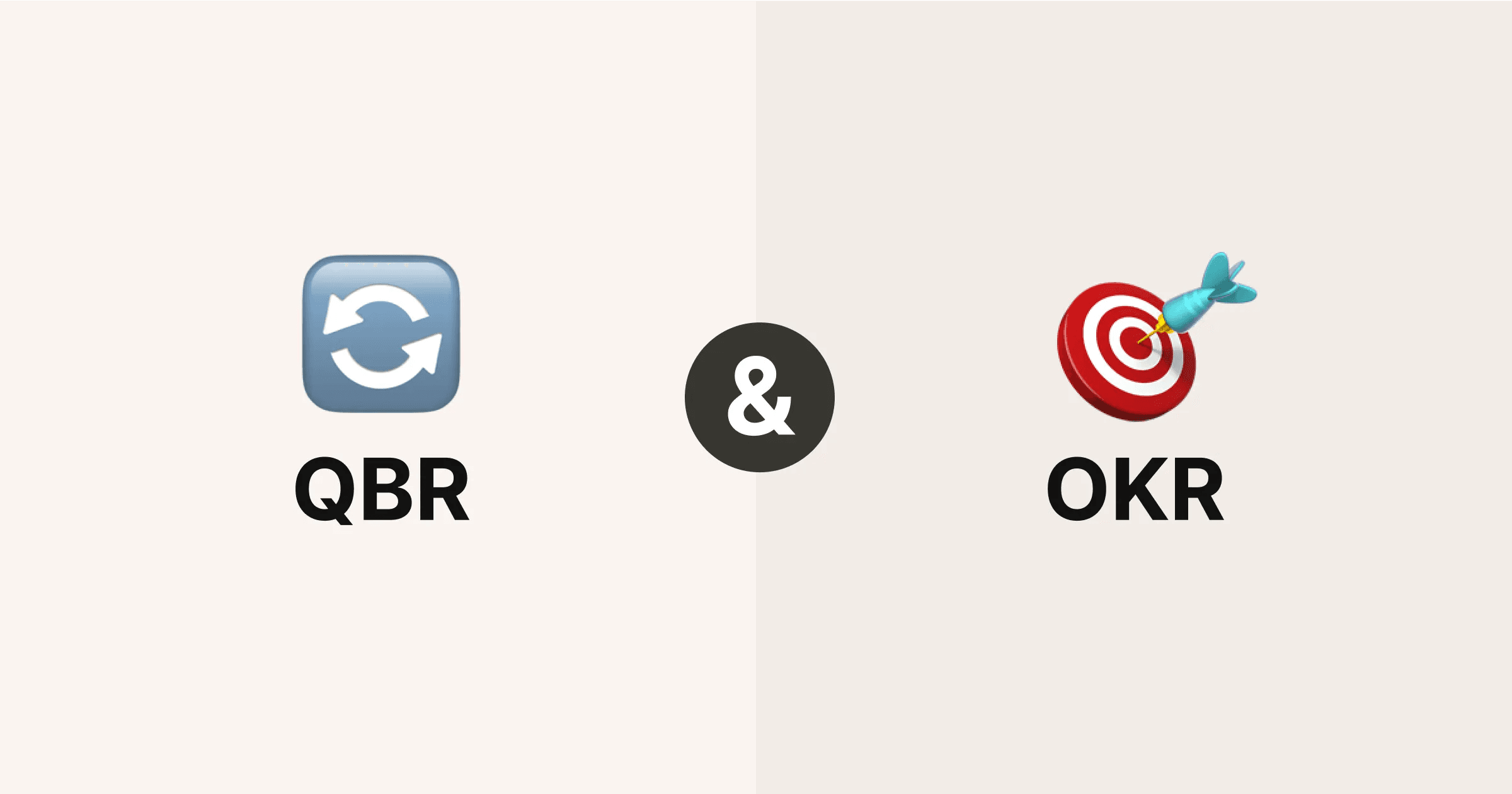
Transparency and multilateral alignment are the cornerstones of agile organizations. However, achieving and maintaining clarity within a larger company can be a real challenge. QBRs (quarterly business reviews) can help overcome this problem, especially when combined with OKRs.
Up next we will clarify what exactly a quarterly business review is, why it’s important, and how successful QBRs should be prepared. Additionally, we will explain how OKRs complement QBRs and how to use an OKR software to simplify the preparation process.
What to expect:
- What are QBRs?
- What are internal QBRs?
- The importance of QBRs
- How to implement QBR
- Optimizing QBRs with OKRs
- FAQ
What are QBRs?
When speaking of business reviews, one tends to think of the typical annual business review, but there is another type that takes place periodically – the QBR (quarterly business review). These reviews are recurring meetings that take place at the end of each quarter.
There are also two types of QBRs: internal and external.
Internal QBRs are meetings held once per quarter between teams or departments in a business. The main goal is to review, plan, and manage the company's strategy, grow its revenue, and align teams with the company’s top Objective.
External QBRs are linked to internal QBRs but are shared with customers. In these meetings, the customer service team shares key findings and developments from the internal QBR with the company's most important customers.
This article will focus on internal QBRs and how they can help realize a company’s strategic goals.
What are internal QBRs?
An internal QBR is a tool that makes a company's strategic goals easier to achieve through quarterly discussions. These meetings are designed to align stakeholders with the company’s future plans and assess its current performance and needs.
When done right, internal QBRs can boost a company's growth by addressing issues early, pinpointing growth opportunities, and improving connections between departments.
⏱️ ️Duration and frequency:
- Usually held once per quarter
- Typically takes place at the very end of the quarter
- It can take 1 to 2 hours or even more to complete the QBR
What are the objectives of an internal QBR?
For the most part, internal QBRs focus on summarizing and analyzing the progress made toward the company’s KPIs, OKRs, and strategic goals within a quarter. They follow a quarterly routine that aims at clarifying the following topics:
- What are the company’s strategic goals and how can teams contribute to them?
- Has the company progressed toward strategic goals since the last QBR?
- Are the methods and approaches in place working? Why or why not?
- Have there been any changes regarding the strategic goals, budget, or resources available?
- How should the teams adapt to the new changes? Are new OKRs needed?
- What steps should be taken in the next quarter?
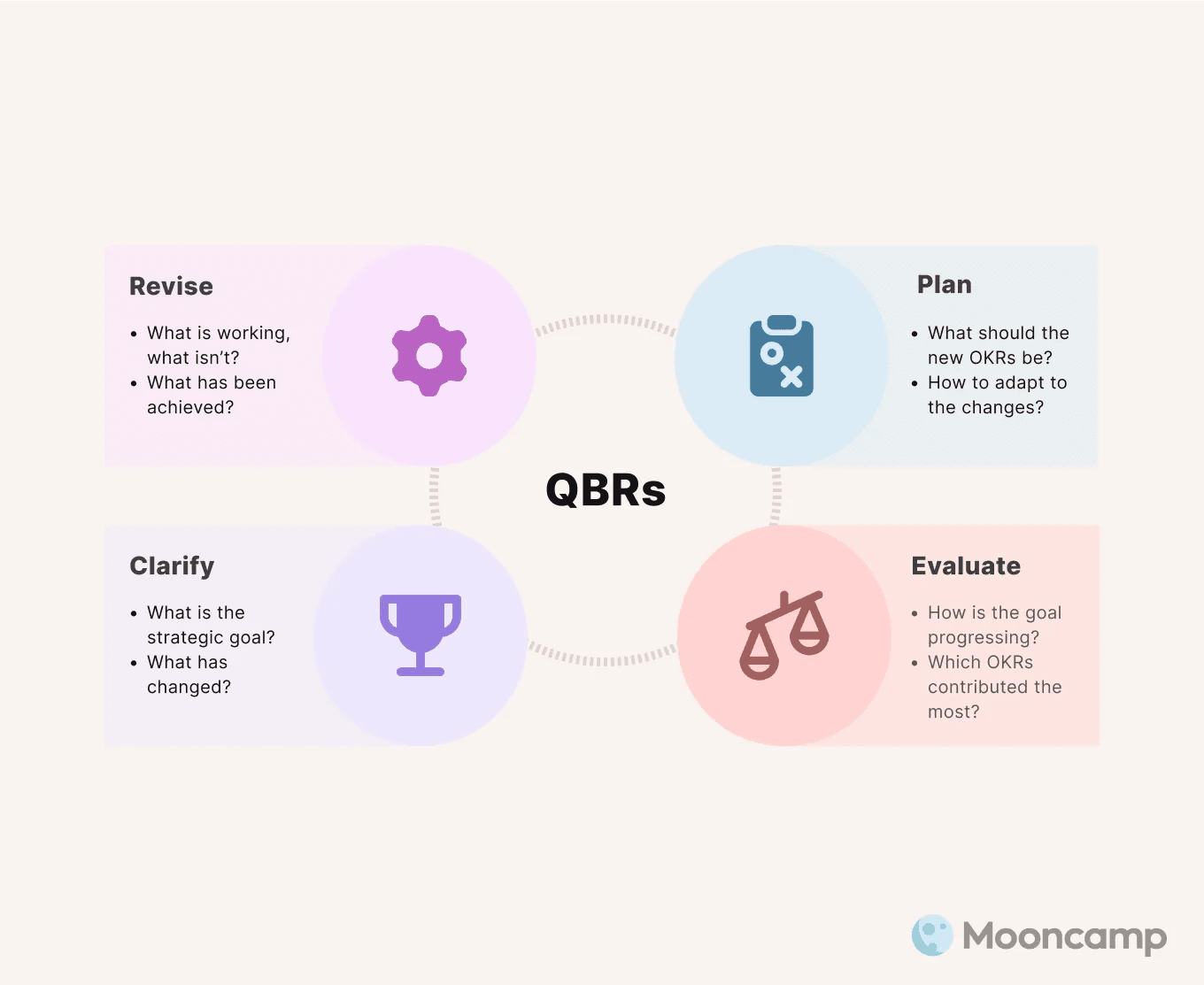
In essence, internal QBRs are used to check whether companies and employees are still "on track" with strategic goals and to decide whether and how the tactical approach should be optimized for the next quarter.
To do this, one first has to invite the right kind of people to the QBR.
Who should be invited to a QBR?
Internal QBRs are used to review performance and plan for the future, so it makes sense to involve all key players and decision-makers who impact the company's direction and strategic goals.
The QBR attendees typically include members from the following teams:
- Leadership: This includes the CEO, CTO, CFO, and other top executives. This team provides direction, makes key decisions, and is responsible for the overall success of the company.
- Sales: Being the initial point of contact with customers, they can provide direct feedback and insights on market demands, customer preferences, and competition.
- Marketing: They contribute insights into promotional strategies, customer acquisition, and market trends, which is vital for future planning.
- Product Management: This team can provide updates on product development, as well as future roadmaps, and can align these with business goals and market needs.
- Customer Success: They give valuable input on customer satisfaction, product usage, and customer retention strategies.
- Operations/Finance: They provide insights into the company's financial health, operational efficiency, and resource allocation.
Each quarter, a QBR squad is selected, made up of team representatives and, if needed, key team members. They are chosen because they each bring a unique and valuable perspective on the company's performance, future strategies, and goal alignment.
Together, they create a comprehensive review of the past quarter and enable strategic planning for the future.
Note: It's important to get the right mix of people for the QBR. You need a focused group, but it's also crucial to have all key perspectives represented. Usually, only one person per team, often the leader, shares their team's progress and findings. However, QBRs should also include people who significantly contribute to the company's strategic goals. Therefore, the number of participants in a QBR can vary from a handful to several dozen, depending on the organization's size and the topics discussed.
Now you have a better understanding of what internal QBRs are, but why are QBRs especially relevant in today’s connected world?
The importance of QBRs
In today's dynamic world, adapting to market changes and customer preferences is crucial for success. This requires thought-out strategies and setting strategic goals. But many obstacles can derail the strategy execution.
This is where QBRs come in handy. Let's delve into the challenges QBRs help address during strategy execution.
Having an unclear mission and vision
The vision and mission are essential for guiding a company's strategic goals. The vision outlines the desired future, and the mission defines the current purpose, helping employees understand what needs to be achieved and how.
Without a clear vision and mission, confusion about task relevance and demotivation can occur.
✅ Solution: Regular QBR meetings can help avoid this by reminding executives of the vision and mission, addressing any changes, and ensuring communication across teams and departments. This keeps the QBR participants informed about the company's direction. It also maintains the focus on strategic goals by breaking down the vision and mission into specific strategies and projects. After the QBR meetings, leaders can use the OKR planning session to convey the findings of the QBR to their teams and/or departments and break down the strategic goals into team-level OKRs.
Confusing the output and outcome
Often, “output” and “outcome” are wrongly used as synonyms. However, “output” is a measurable and quantitative result of an activity, whereas “outcome” is the actual value that a product or service adds for the target audience.
Essentially, outcomes' are the real goals of your business, while output is the result of specific activities or initiatives undertaken to progress towards those goals.
Confusing these terms can lead to misunderstandings.
✅ Solution: QBRs address this issue by requiring teams to assess and summarize the progress of specific tasks (output), and also to discuss how these achievements contribute to the overall goal (outcome). This enables teams to effectively analyze progress and develop an action plan for the next quarter that drives the desired outcome.
Lack of transparency
It's crucial for everyone to know and understand the company's strategic goals for any plan to be successful. Sharing these goals and the overall strategy with all company levels guarantees everyone is aligned and working towards the same end goal.
A lack of transparency can lead to prioritizing the wrong tasks or goals and delay decision-making.
✅ Solution: QBRs help maintain transparency. They are designed to help the different departments and team leaders comprehend the current situation, the desired outcome, and the path to get there. By being aware of changes in budget, resources, and vision, department leaders can allocate resources and prioritize goals more effectively. When paired with OKRs the changes can also easily be communicated at the team and individual level after the QBR. This enables teams to adapt quickly to any new changes in the company,
Skill gaps within teams
For success, every employee must understand the objective and have the necessary skills to advance it.
When underperforming employees are overlooked, it becomes challenging to discern why certain goals remain unmet. Teams might miss vital tasks if some members lack the required expertise, leading to miscommunications and misprioritization.
✅ Solution: QBRs enable executives to swiftly identify underperforming goals or teams. This allows them to focus on team members who might be facing challenges. By providing these employees with the right resources and support, executives foster a culture of growth and bridge the skill disparities across teams and departments.
Let’s recap what we just learned: QBRs help achieve strategic goals by…
- breaking down the company’s mission into specific tasks, projects, and strategies
- aligning the goals of the different departments with the strategic goals
- promoting data-driven and outcome-oriented decision-making
- providing transparency
- helping management allocate resources efficiently
- pinpointing problems early on
- clarifying changes in the strategy and quickly realigning the course of action
- identifying and reducing skill gaps
The benefits of QBRs don’t happen overnight, though. To achieve strategic goals with the help of QBRs, the meetings must first be conducted properly.
Preparing the QBR process
Define the strategic goals
The strategic goals set the tone. Thus, defining the strategic goals is the first step. Once this is done, the goals surrounding the QBRs can be set. These should ideally be SMART goals that build up to the strategic goals.
Select a QBR owner
QBRs require thorough preparation, organization, and moderation.
This is done by the QBR owner who is usually an executive.
He or she organizes, moderates, and guides everyone through the QBR process, ensuring the meeting stays focused. They also choose the QBR invitees.
💡Tip: Ideally there should be a functioning goal-tracking system such as OKRs in place before the QBR process is started. If not, the QBR owner must integrate one. Failing to establish a goal-tracking system may otherwise hinder the team’s data-gathering process.
Invite the right people
The QBR owner chooses the team representatives who will participate in the QBR.
He or she must make sure that the participants understand the company’s current state, what the strategic goals are, how the goal-tracking system works, and what their roles toward the strategic goals are.
Participants should be invited to the meeting at least a month in advance so that they can gather the necessary information and prepare for the meeting.
Preparing a QBR agenda
To keep the meeting on track the QBR owner should prepare a QBR agenda and share it with the invitees early on.
The QBR agenda provides an overview of the structure and topics of the meeting and helps keep the meeting short and to the point.
Having a well-defined agenda establishes clear expectations, making it easier for participants to prepare, and formulate their key questions and discussion topics in advance.
QBR agenda
As a rule of thumb, the QBR meeting structure should be organized around three main themes: performance review, progress analysis, and strategic planning.
A sensible agenda for a QBR might look like this:
- Introduction and warm-up (5-10 minutes)
- Performance review (10-20 minutes)
- Success and challenges (10-20 minutes)
- Realignment (15 minutes)
- Strategic planning (30 minutes)
- Open discussion and Q&A (10-20 minutes)
- Closing and next steps (5-15 minutes)
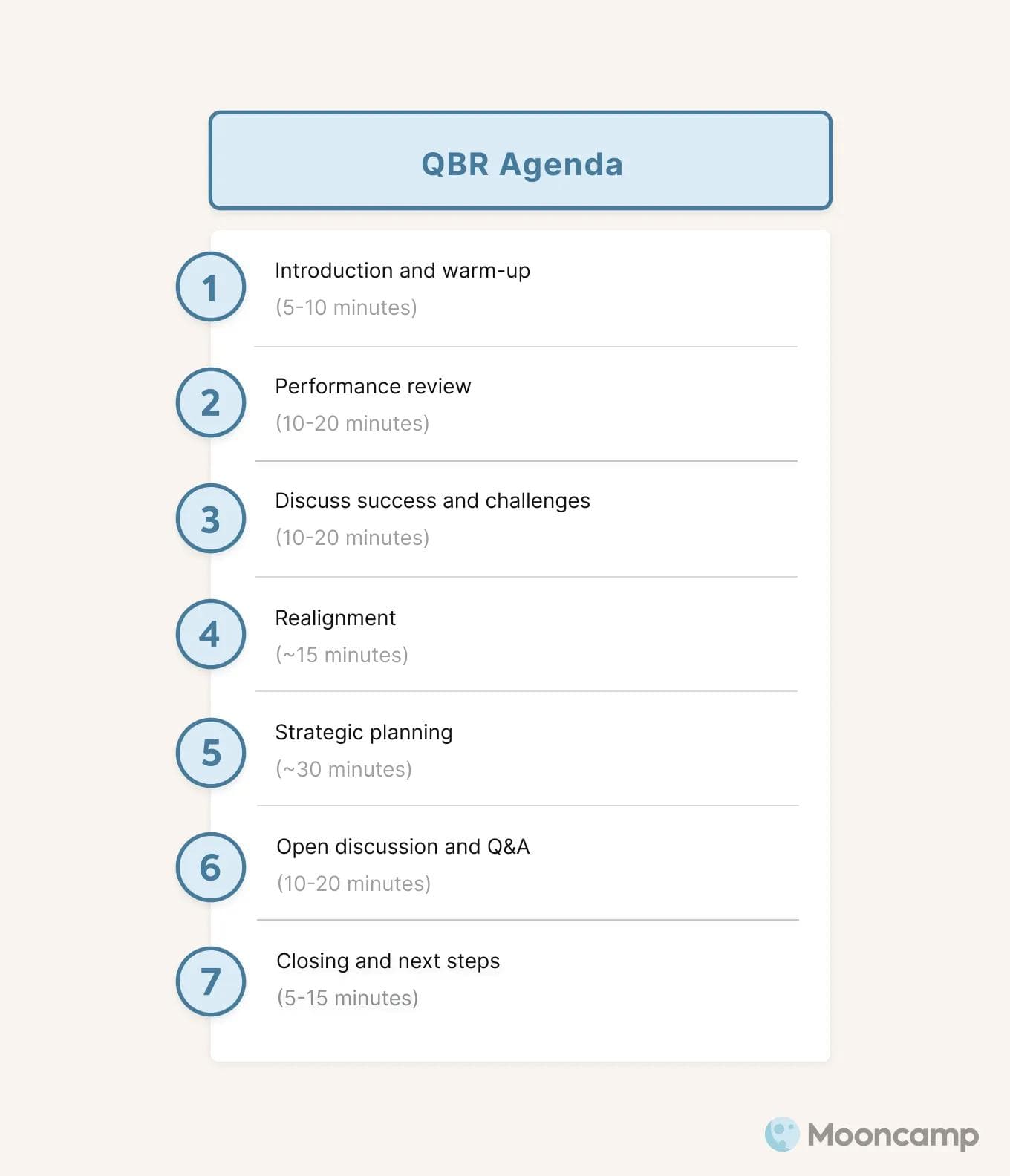
💡Tip: Before the meeting begins, the QBR owner should appoint someone to transcribe the meeting. The person should summarize and highlight the most important points discussed in the meeting. Once completed, the transcription should be sent to the participants.
1. Introduction and warm-up
The meeting begins with a brief welcome and introduction by the QBR owner. This helps make the participants feel welcome and encourages them to express their opinions. The QBR owner should then briefly introduce the topics and goals of the meeting.
2. Performance review
Next, the goals set in the previous QBR are reviewed to evaluate progress. This involves discussing what was achieved and what was not.
Each representative shares their team's contributions to the strategic goal, using KPIs, OKRs, and goal-tracking systems for analysis. This crucial part of the QBR helps teams understand their performance and identify gaps or areas for improvement.
💡Tip: For this step, teams can use the information gathered in their OKR reviews.
3. Success and challenges
In this part, teams can use the findings from their OKR retrospectives to present their key successes and challenges from the past quarter and reflect upon their work performance.
It's important to recognize the team's efforts and talk about what went right. But it's also crucial to identify what didn't work, discuss any team misunderstandings or issues, and then think up solutions together.
The goal here is to learn from the past and improve the way everyone works together.
Important: Criticism and performance evaluations are not part of QBRs and should be avoided. Problems should be discussed and tackled quickly.
4. Realignment
Goals and visions rarely stay the same. That’s why it’s important to talk about what has changed within the organization.
In this step, the biggest changes should be laid out clearly and the Objectives should be realigned according to said changes.
Possible questions that should be answered:
- Has the company’s strategic goals or vision changed?
- Are there any changes to resources? Do we have more or less resources than before?
- Has the budget changed or will it change in the future?
5. Strategic planning
Lastly, using the knowledge gathered in the previous steps, team members should make suggestions about which Objectives should be removed, adjusted, or prioritized.
The key goals for the next quarter are then discussed and agreed upon by the team – these goals should be aligned with the strategic goals of the organization. They must then be broken down into specific tasks and assigned to the different departments, teams, and individuals.
Important: After the meeting, the different team representatives must promptly communicate the new responsibilities and goals to their teams. This ensures that everyone is accountable and keeps the goal on track after the meeting.
6. Open discussion and Q&A
The importance of an open forum for participants to ask questions or discuss topics that have not been covered in the meeting should not be underestimated.
Making the time to address any concerns or issues that may have been raised during the meeting is essential.
7. Closing and next steps
At the end of the meeting, the QBR owner should summarize the key takeaways, outline the next steps, and set deadlines for any follow-up actions. Thank all participants for their contributions and close the meeting.
But the work doesn’t end there.
Once the QBR is completed the QBR owner must promptly send out a summary of the meeting, including any decisions that were made, and make sure that everyone knows and implements the next steps.
This follow-up process is crucial.
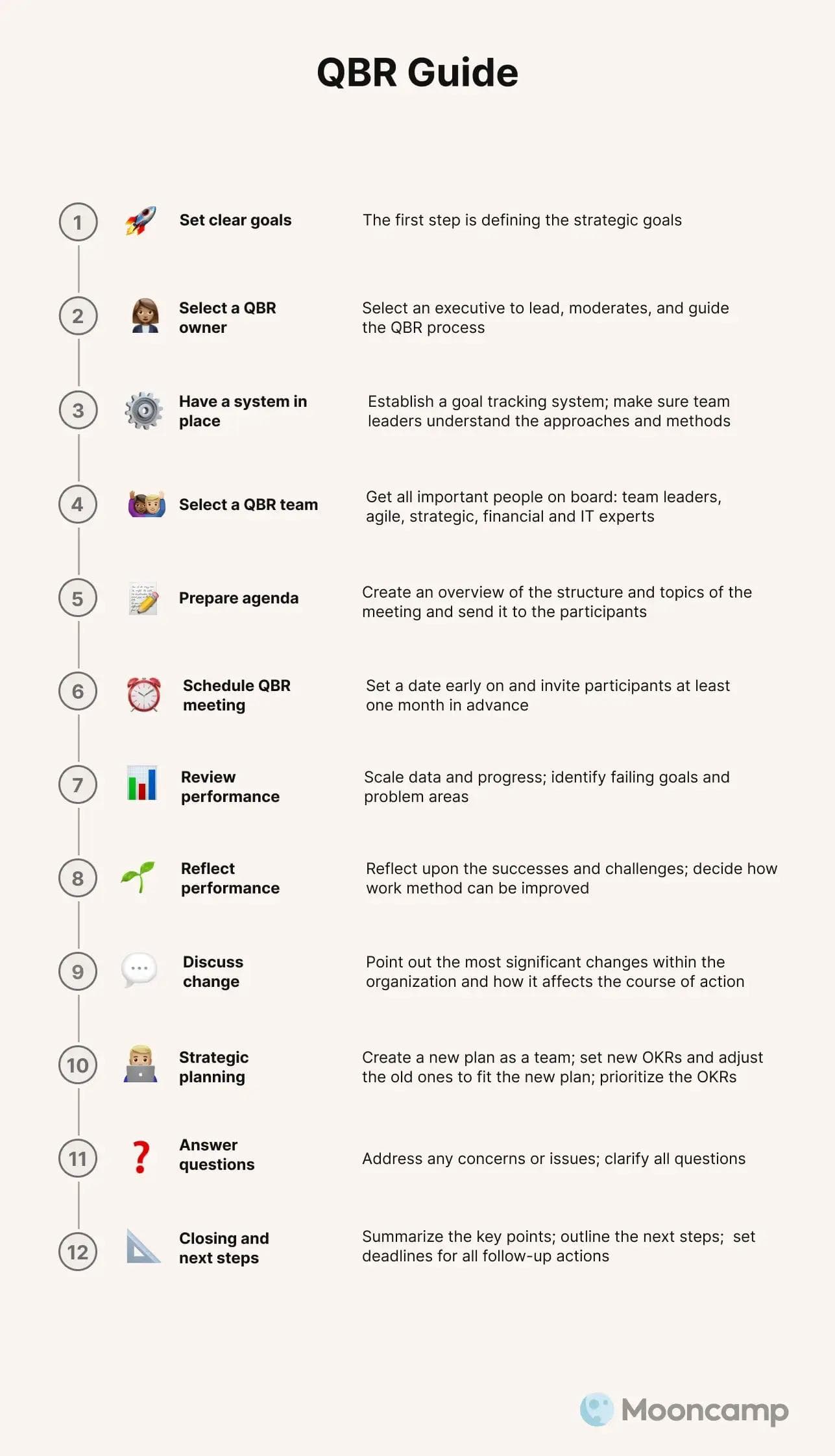
Common QBR pitfalls to avoid
QBRs can be extremely beneficial, but only if they are executed correctly. Unfortunately, many companies make mistakes throughout the QBR process that diminish the effect of the QBR.
- Lack of preparation: Not having all the relevant data or not being fully prepared can lead to an unproductive QBR. It is important to continuously track and update progress in order to be able to prepare properly.
- Going off-topic: It's easy to get sidetracked during a QBR, so it's important to have a clear agenda and stick to it.
- Not involving the right people: If key stakeholders are missing from the QBR, it can lead to a lack of buy-in and support for the decisions that are made.
- Focusing too much on the past: While it's important to review past performance, the main focus of the QBR should be on the future.
- Not following up: Without proper follow-up, the decisions made during the QBR may not be implemented or may be forgotten rendering the QBR redundant.
This is where OKRs come in handy, they are the key to preventing QBR pitfalls.
OKRs – the key to effective QBRs
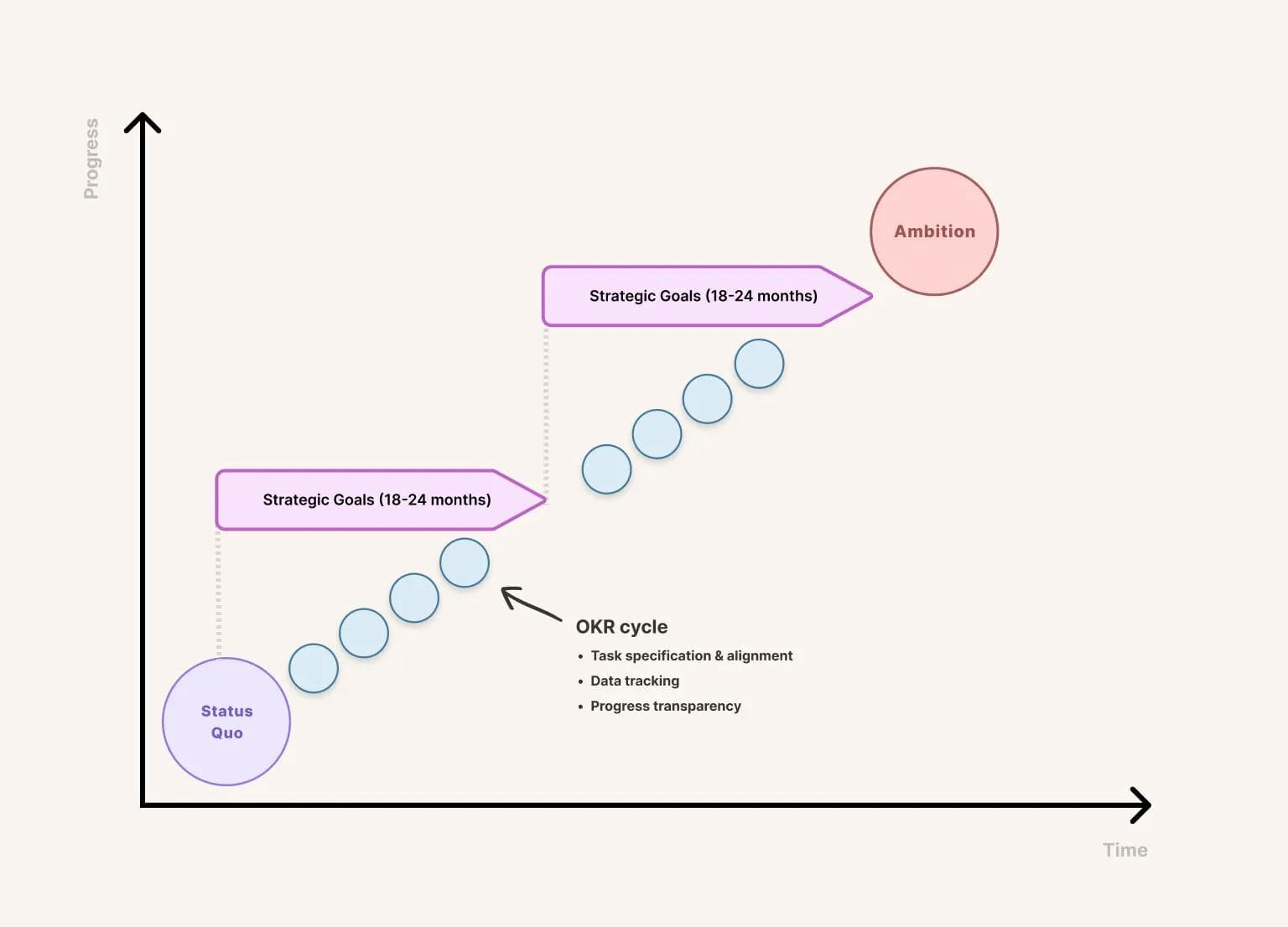
💡 Reminder: OKR (short for "Objectives and Key Results") is an agile framework for formulating and implementing strategic goals in companies that consists of three core elements:
- Objectives: What do I want to achieve?
- Key Results: How do I know that the goal has been achieved?
- Initiatives: How do I achieve the objective?
As a rule, 2 to 4 Objectives are formulated per team and 2 to 4 result-oriented Key Results per Objective. The output is mapped in initiatives (= concrete activities). More basic knowledge can be found in our OKR guide.
Saving time by preparing QBRs with OKRs
Preparing QBRs can be quite time-intensive, and by the time the quarterly data is ready, it can sometimes be outdated. Luckily, OKRs help the team representatives gather and deliver the right and up-to-date content for QBRs. Here’s how.
Measurable Key Results
The OKR framework consists of Objectives with respective Key Results, which are specific, quantifiable outcomes.
The Key Results serve as the metrics that are used to assess progress toward achieving an Objective and are defined at the beginning of the quarter.
By having predefined metrics, the preparation process is simplified since one no longer needs to identify which metrics and data need to be discussed and analyzed during the QBR.
Clear Objectives
OKRs require setting clear and concise Objectives for the quarter.
Having these clear Objectives established at the beginning of the quarter removes any uncertainty or confusion about what the organization or team is trying to achieve.
During the QBR, these Objectives can serve as the agenda items, guiding the discussion and keeping it focused on what matters most, ultimately reducing the risk of going off-topic.
Prioritization
OKRs help in prioritizing the most important goals and Key Results by forcing teams and individuals to focus on a limited number of Objectives. This gives them guidance and ensures that the most critical aspects of the business are addressed during the QBR.
It also helps keep meetings concise by focusing the discussion on the most important topics.
Continuous monitoring
The OKR framework encourages continuous monitoring of progress throughout the quarter.
Teams and individuals are expected to regularly update their progress toward Key Results in the weekly check-in meetings.
This means that there is no need for a massive data collection and analysis exercise before the QBR, as most of this work has been done continuously throughout the quarter.
It also means that problems can be pinpointed early on throughout the OKR cycle and can be dealt with prior to the QBR. Additionally, monthly or even weekly OKR check-ins are an extremely helpful complement to the broader and more infrequent QBRs, to course-correct an organization’s strategy.
As Karen Peacock, former CEO of Intercom, puts it:
Transparency
OKRs enhance transparency by making the goals and progress visible to everyone, from executives to individual contributors. This not only personalizes the goals but also creates vertical and horizontal alignment, reducing the need for detailed updates during the QBR as everyone is already aware of the current status.
This leaves more time during the QBR to plan the next steps, keeping the focus on the future rather than the past. Additionally, such a level of transparency ensures that individuals are held accountable and keeps them focused on the task well after the QBR.
💡 Tip: If you want to get a closer look at the benefits of the framework, you can find an overview of the most important OKR benefits on our blog.
Let’s recap what we just learned: OKRs prevent QBR pitfalls by…
- facilitating the implementation of QBRs
- simplifying the preparation process through measurable Key Results
- keeping everyone on track through specific and clear Objectives
- focusing on the most important tasks – keeping the meeting concise
- pinpointing problems early on through check-ins
- providing transparency and keeping a forward focus approach
- ensuring individuals are accountable and stay focused on the goals post QBR
On its own, the OKR framework delivers. Yet, when paired with an OKR tool like Mooncamp, it becomes a force multiplier.
QBRs with OKR software
Oftentimes the biggest challenge of QBRs is the organizational feat of gathering and analyzing the data. With OKR software like Mooncamp, this problem can easily be tackled.
- Centralized data: Mooncamp provides an OKR dashboard where all Objectives and Key Results are recorded, tracked, updated, and consequently summarized in a visually appealing way. As such, through the OKR dashboard, participants can find all relevant information needed for the QBR in one place. Furthermore, with Mooncamp you can create custom dashboards that can be used for a range of use cases and report types – including QBRs.
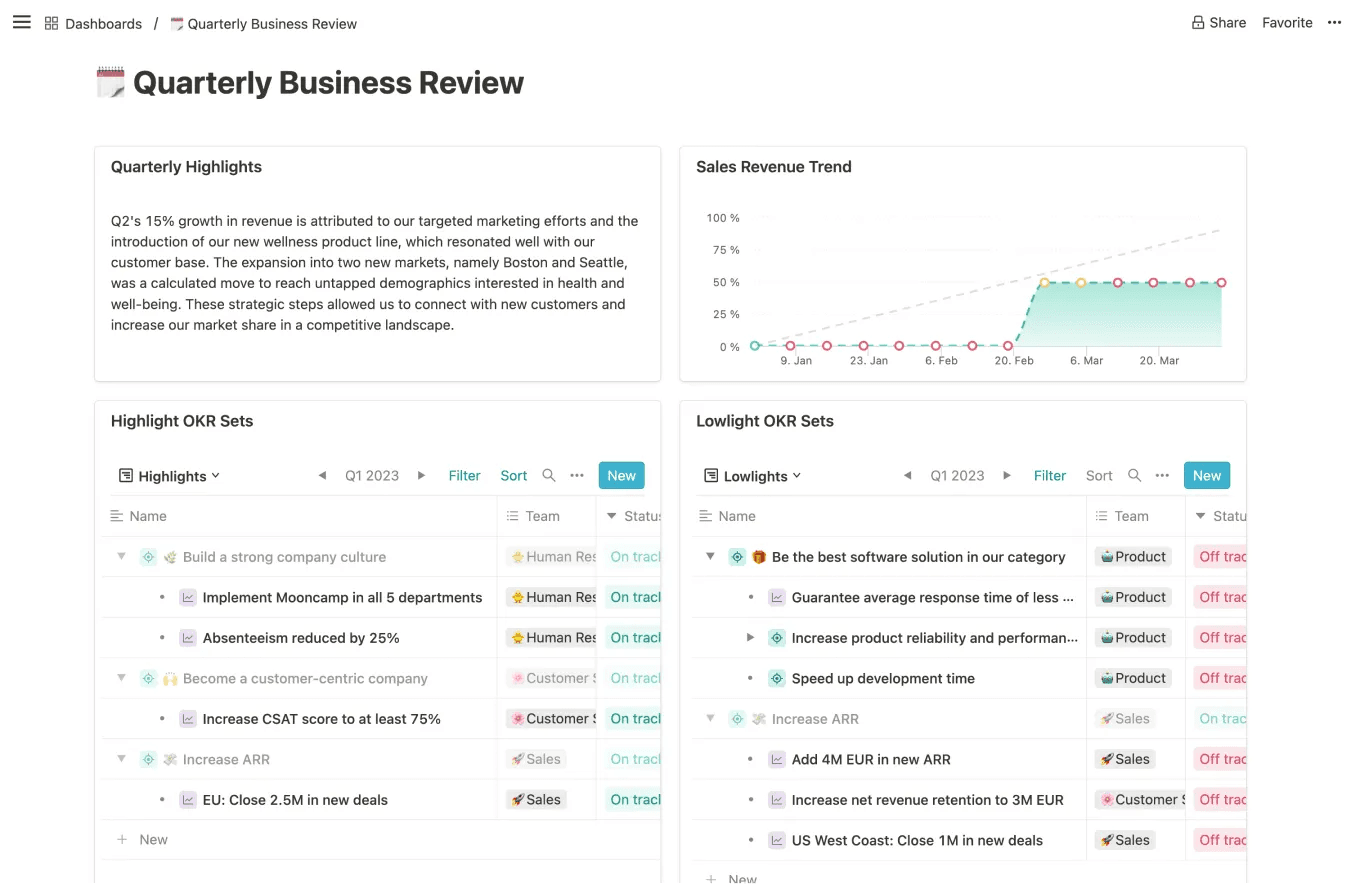
- Real-time tracking: With Mooncamp team members can update their progress as they work on tasks. The software then automatically updates the progress and enables real-time tracking of progress towards Key Results. This means that the most up-to-date information is available during the QBR, reducing the need for last-minute data collection and update.
- Data analysis: The OKR reporting process is also simplified through Mooncamp since the OKR software includes data analysis tools such as a progress dashboard that can help identify trends, strengths, and areas for improvement early on. This can provide valuable insights during the QBR and help make informed decisions for the next quarter.
- Integration: Mooncamp can also be integrated with other tools and platforms such as MS Teams, Slack, and more. Through this, it is easier to include all relevant data in the QBR and mistakes can be avoided, as it reduces the need for manual data collection and entry.
Conclusion: QBRs + OKRs = Dream Team
An internal QBR is a great tool to reach strategic goals, but it requires careful preparation and follow-up work to succeed. OKRs can help with this.
OKRs ease the QBR preparation by defining clear, measurable goals and monitoring progress. Analysis and data collection can also be simplified through the integration of OKR software. Lastly, pairing OKRs with QBRs helps connect strategic goals to quarterly goals and daily tasks, keeping teams on track well after the QBR.
FAQ
QBR best practices
- Set clear Objectives: Define clear and measurable objectives for the QBR. Everyone should know the purpose of the meeting and what needs to be achieved.
- Prepare ahead: Ensure all participants have access to relevant data and documents well in advance so they can come prepared.
- Be Selective About Attendees: Only invite key stakeholders who can provide valuable insights and decisions.
- Follow a Structured Agenda: Have a clear and structured agenda that covers a review of the past quarter, discussion of challenges, and planning for the next quarter.
- Focus on Data: Use data to drive discussions and decisions. Avoid opinions and assumptions.
- Encourage Participation: Foster an environment where all participants feel comfortable sharing their thoughts and feedback.
- Assign Action Items: Clearly assign action items and responsibilities to ensure follow-through after the meeting.
- Schedule Regularly: Hold QBRs consistently every quarter to maintain alignment and momentum.
- Follow-Up: After the QBR, send a summary of the meeting, including key decisions made and action items assigned, to all participants and relevant parties.
Why are OKRs beneficial to the QBR process?
OKRs offer clarity by setting clear Objectives and measurable Key Results, which ensures everyone is aligned. This makes the QBR process more streamlined as teams can directly review progress towards these predefined goals.
How are QBRs different from regular team meetings?
QBRs are more strategic and focus on a broader timeframe (the past and next quarter), whereas regular team meetings are usually more tactical and focused on day-to-day or week-to-week operations.


